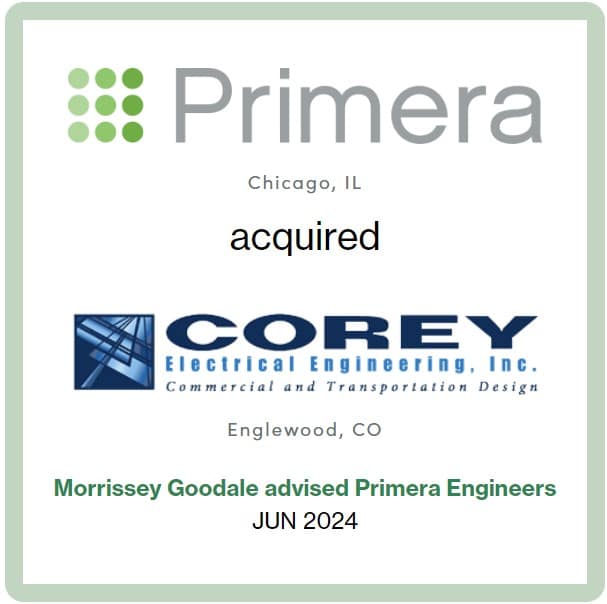Word on the street > The (Almost) Mid-Year M&A Update; What Does It Take to Get Young Professionals to Break the 40-Hour Barrier?
Word on the Street: Issue 199
Weekly real-time market and industry intelligence from Morrissey Goodale firm leaders.

The (Almost) Mid-Year M&A Update
It’s that time of the year again. With Memorial Day in the rear-view mirror, the corporate development folks running deals for acquirers are headed to the shore (or the mountains) for some well-deserved R&R.
Chilling by their Solo Stoves, they’ll give themselves a pat on the back for the acquisitions they’ve helped their firms make year-to-date. Grilling by the pool, they’ll rue the deals that got away. And gazing up at the stars through the clear panels of their luxury glamping domes, they’ll be planning how to close out their “must-have” deals in the months remaining in 2024.
Meanwhile (and maybe even unwittingly on the same shore or mountain), sellers will be diligently gathering and compiling all of the digital materials and reports they will need to realize a smooth sale of their firms by the end of the year.
By all accounts, it will be yet another busy second half of the year for both serious buyers/investors and motivated sellers. Let’s take a look at the state of the 2024 M&A market that they will both be diving into.
1. Busy, busy, busy: OK, with that lead-in you’d be forgiven for thinking 2024 is seeing record deal-making activity. Well, you’d be wrong (🙁). But not by much (😊). We tracked 204 U.S. transactions through the end of May—essentially on pace with last year. And while that’s a decline of some 13% over the same period in record-smashing 2022, we’re solidly on track to see a third consecutive year of 450 plus/minus deals. Why is that notable? At that level, we’re squarely in a period of time where meaningful single-digit percentages of the industry are being consolidated annually. We’re right in the middle of “peak consolidation” territory. Frankly, there’s never been a better time to sell your firm.
2. Super-sized deals: For as long as we have been keeping records, the median acquirer size has never exceeded $98 million. And the median seller size has consistently ranged between gross revenues of $2.5 million and $3.5 million. Well, the first five months of this year have seen those norms disrupted. The median size acquirer has jumped to $147 million, while the median seller size has popped to $4.25 million. The first change is easier to explain. The bigger buyers are getting more active. It’s harder to say why the seller size has increased. One theory is that buyers are reallocating their limited M&A deal-making resources to effect relatively more, larger “needle-moving” deals. Whatever the reason, it’s bad news for smaller firms that have been shut out of deal-making.
3. Capitalization churn: Employee-owned acquirers accounted for just over half (106) of the deals completed through the first five months of the year. Another 40% (82) were completed by either private equity-backed operating firms or were recapitalizations by private equity groups. Publicly traded acquirers made 16 acquisitions over the same period. These capitalization categories line up pretty closely to the buyer profiles that we have seen over the past three years.
4. More private equity at the top: Fourteen ENR Top 500 design firms have sold or recapitalized in 2024. If this pace keeps up, it will be a record year of consolidation among the nation’s leading designers. Continuing a trend that we have been tracking since 2018, the vast majority (85%) of those top designers either sold to a private equity-sponsored acquirer or were recapitalized as a private equity-backed platform.
5. The big three: Almost one-third of all deals this year have taken place in California (24), Florida (23), and Texas (19). This continues the trend that we have tracked for a number of years, with these three states accounting for between 30% and 35% of U.S. consolidation. Interestingly the number one and number three spots this year are reversed compared with last year—when Texas was the most active state.
6. Big talk, less action: Despite continued interest from overseas acquirers in the U.S. market, just 5% of transactions year-to-date involve an overseas acquirer. This is up from 3% last year. The last time overseas buyers played a significant role in U.S. industry consolidation was back in 2017, when they accounted for 10% of acquisitions.
7. Movers and shakers keep doing what they do: Way back in January, we wrote about “Nine Movers and Shakers to Watch in 2024.” These were nine firms that we believed would make some of the most impressive and meaningful acquisitions in the industry this year. And sure enough, they’ve continued their impressive growth through acquisitions. Of the nine firms, eight have made multiple acquisitions year-to-date: IMEG (5), NV5 Global (5), Verdantas (5), Salas O’Brien (4), Bowman Consulting Group (4), Atwell (2), SAM (2) and RMA Companies (2).
8. Excellence in Acquisitive Growth Awards: We’re on a mission to improve how consolidation happens in the industry. And as part of that, we’re recognizing those acquirers that are making it happen. Bowman Consulting Group (ENR #78) is this year’s recipient of the industry’s Most Proficient and Prolific Acquirer Award. And Trinity Consultants is the recipient of the 2024 M&A Best Practices Award—which will be presented this week at our Western States M&A and Business Symposium in Las Vegas. The third award in the annual Excellence in Acquisitive Growth Awards Series is the Best Post-Transaction Performance Award, which will be presented at the Texas and the South M&A and Business Symposium at the five-star Post Oak Hotel at Uptown Houston in October.
Questions? Comments? Suggestions? You can reach Mick Morrissey @ 508.380.1868 or [email protected].
What Does It Take to Get Young Professionals to Break the 40-Hour Barrier?
The modern mindset: Prioritizing work-life balance
For a long, long time—mainly out of frustration—AE leaders would relentlessly harp on the poor work ethic of the younger generations, perhaps thinking that indirect shaming might cure what ails them. But over the last few years, frustration has gradually become resignation as millennials and Gen Z have fundamentally altered the professional landscape. Their approach to work-life balance is not just a preference but a non-negotiable aspect of their careers. Unlike the older generations who often subscribed to the “work long, work hard” mentality, these young professionals are seeking a more harmonious integration of work and personal life—and there’s no going back.
When it comes to the work component of work-life balance, they aren’t just looking to clock in and out. They want their professional lives to coexist seamlessly with their personal pursuits. Flexible hours, the option to work remotely, and an overall respect for their time outside of work are critical. For them, work-life balance isn’t about working less; it’s about working smarter and ensuring that their work enhances rather than detracts from their overall well-being.
Inspiration and motivation: What drives young professionals?
To truly engage and motivate the younger generations, it’s crucial to understand what gets them fired up about their careers. Here’s what makes them tick:
- Meaningful work. These young guns are looking to make a real difference. They’re drawn to projects that align with their values, such as sustainable design and community-focused initiatives. They want their work to matter and to contribute to a better world.
- Career development. Continuous growth is a must. They’re eager to learn, advance, and evolve in their careers. Clear pathways for progression, access to mentorship, and opportunities to expand their skill sets are essential motivators.
- Autonomy and creativity. They crave the freedom to innovate and the autonomy to drive their projects. Micromanagement? That’s a sure way to kill their enthusiasm. Trust and the space to bring their ideas to life are key to keeping them engaged.
- Collaborative culture. A work environment that promotes teamwork and inclusivity is highly valued. They thrive in settings where open communication and diverse perspectives are the norm, not the exception. This collaborative spirit not only boosts morale but also fosters innovation.
Demotivation: What drives young professionals up the wall?
It’s equally important to understand what tends to sap their drive and passion, including:
- Overwork and burnout. The expectation to put in excessive hours is a major turnoff. But given record backlogs and the well-documented dearth of talent, burnout is a real threat—and young professionals are keenly aware of its impact on mental and physical health. They’re not interested in sacrificing their well-being for their careers.
- Lack of recognition. Feeling undervalued or unappreciated can be a deal-breaker. Regular recognition and appreciation for their contributions are crucial. Without it, they can quickly become disengaged. A thank you every now and then goes a long way—and it’s free.
- Stagnation. They want to keep moving forward. Limited growth opportunities or a lack of career progression can lead to frustration and a desire to seek opportunities elsewhere.
- Rigid work environments. Inflexibility in work schedules and environments can be highly demotivating. They value the ability to balance their work with their personal lives, and a rigid workplace can stifle their productivity and satisfaction.
Leadership strategies: Encouraging a willingness to exceed expectations
So, how can AE leaders inspire these young professionals to willingly put in more than the standard 40-hour week when duty calls? It starts with aligning the work environment with their values and aspirations. Here’s how to do it:
- Flexible work arrangements. Offer flexibility in schedules and work locations. Remote work options, flexible hours, and understanding their need for personal time can lead to greater loyalty and willingness to go the extra mile.
- Purpose-driven projects. Engage them with projects that align with their passions. Work focused on sustainability, innovation, and community impact can inspire them to invest extra effort and time.
- Recognition and reward. Implement strong recognition and reward systems. Regularly acknowledging their hard work and offering incentives for exceptional performance can boost morale and motivation. But first, make your expectations crystal clear.
- Professional development opportunities. Invest in their growth. Providing training, mentorship, and clear career progression pathways can inspire them to give their best. Share your knowledge and your network with them.
- Inclusive and collaborative culture. Foster a workplace that values collaboration and inclusivity. Encouraging teamwork and valuing diverse viewpoints can create a positive, motivating environment. Be ultra-vigilant about breaking down silos and turn “your work and my work” into “our work.”
- Wellness programs. Promote wellness and prevent burnout with programs that address mental and physical health. Offering resources for stress management and overall well-being shows you care about their health, which in turn can inspire greater commitment. Make sure you lead by example in this regard.
- Open communication. Maintain open lines of communication and involve them in decision-making processes. Valuing their feedback and acting on it can make them feel more invested and willing to put in extra effort. Don’t just hear them. Listen. And that means not arguing with them mentally. Listen for understanding, not agreement.
The younger generations are setting new standards for what they expect from their careers. They demand a work-life balance that allows them to thrive both professionally and personally. AE leaders that are willing to understand, accept, and even embrace this reality will get the best these young professionals have to give.
Questions? Comments? Call or text Mark Goodale at 508.254.3914 or email [email protected].
Market Snapshot: Employment Projections
As an industry, we have been keeping a close eye on employment figures and trends. Many architects and engineers are watching the jobs report closely as it will impact the Fed’s decision of when to cut interest rates. Looking ahead, demographic changes will significantly impact the overall labor force participation rate in the U.S. Productivity and innovation will be key, not only for industries to meet demand with a smaller pool of available workers, but also for the U.S. economy to maintain strong levels of growth.
A few months ago, we looked at employment projections for occupations within architecture and engineering. In this post, we include the highest projected overall occupations as well as projections by select industry groups. The Bureau of Labor Statistics models industry employment as a function of industry output, wages, prices, and time by using the estimated historical relationship among these variables.
To learn more about market intelligence data and research services offered by Morrissey Goodale, schedule an intro call with Rafael Barbosa.
Weekly M&A Round Up

Congratulations to HB&A (Colorado Springs, CO): The architecture and planning firm serving the federal, local government, commercial, and non-profit sectors joined employee-owned architecture, engineering, and consulting firm RS&H (Jacksonville, FL) (ENR #66). HB&A Principal Aaron Briggs, AICP, and the other HB&A principal owners are enthusiastic about the opportunities that joining RS&H will bring for the firm and its associates. We’re thankful that the HB&A team trusted us to initiate and advise them on this transaction.

Another congrats to Primera Engineers (Chicago, IL) (ENR #359): The engineering design and consulting firm acquired Corey Electrical Engineering (Englewood, CO), an electrical engineering and consulting services firm serving commercial, institutional, industrial, governmental, and transportation clients. With a strong presence in the Midwest and Mid-Atlantic regions, the addition of Corey’s team extends Primera’s reach into the western United States. We feel privileged that the Primera team trusted us to advise them on this transaction.
Active week for both domestic and global deals: Last week we reported strong M&A activity with a total of 12 domestic transactions, including three deals in the western U.S. We reported other domestic transactions in TX, OH, GA, NJ, and MA. Overseas, there were additional deals in Australia, Malaysia, Canada, Sweden, and Norway. You can check all the week’s M&A news here.
October 16-18, 2024 Houston, TX
Texas and the South M&A and Business Symposium
Over two-plus information-packed days, come together to discuss strategy, innovation, and M&A trends while networking with AE industry executives.
Learn More
AI & Innovation
Tap Into the Power of AI for your Firm
We’re partnering with the AI experts at Thrivence to bring AI Education and Business Solutions to the AE and environmental consulting Industry. Introducing a powerful 90-minute, on-demand AI Masterclass designed and delivered by CEOs for CEOs.

Searching for an external Board member?
Our Board of Directors candidate database has over one hundred current and former CEOs, executives, business strategists, and experts from both inside and outside the AE and Environmental Consulting industry who are interested in serving on Boards. Contact Tim Pettepit via email or call him directly at (617) 982-3829 for pricing and access to the database.
Are you interested in serving on an AE firm Board of Directors?
We have numerous clients that are seeking qualified industry executives to serve on their boards. If you’re interested, please upload your resume here.
Subscribe to our Newsletters
Stay up-to-date in real-time.











